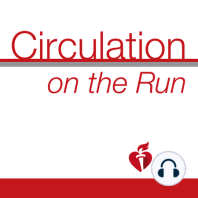25 min listen
Circulation February 27, 2018 Issue
ratings:
Length:
21 minutes
Released:
Feb 27, 2018
Format:
Podcast episode
Description
Dr. Carolyn Lam: Welcome to Circulation on the Run, your weekly podcast summary and backstage pass to the journal it's editors. I'm Dr. Carolyn Lam, associate editor from the National Heart Center, and Duke National University of Singapore. The new ACC/AHA hypertension guidelines are hotly discussed. So much so that we have invited perspectives of these new guidelines from around the world and authors will be discussing this right here on Circulation on the Run. Stay tuned, as it's coming right up after these summaries. The first original paper this week is a translation study suggesting that the parasympathetic system may be a novel therapeutic target in pulmonary arterial hypertension. Co-corresponding authors Dr. Handoko and de Man from University Medical Center Amsterdam used heart rate recovery after maximal cardiopulmonary exercise testing as a surrogate for parasympathetic activity, and assessed white ventricular ejection fraction in 112 patients with pulmonary arterial hypertension. They found that patients with a lower right ventricular ejection fraction had a significantly reduced heart rate recovery compared to patients with a higher right ventricular ejection fraction. Furthermore, they looked at tissues from the right ventricle of 11 patients undergoing heart-lung transplantation, and found that there was increased expression of nicotinic receptors with no difference in muscarinic receptor expression compared to controls. Finally, in a rat model of pulmonary hypertension, they showed that chronic pharmacologic sympathetic stimulation by pyridostigmine, which is an acetylcholinesterase inhibitor, improved surviving right ventricular function and reduced pulmonary vascular remodeling. In summary, the study shows that right ventricular dysfunction is associated with reduced systemic parasympathetic activity in patients with pulmonary arterial hypertension, with an inadequate adaptive response of the cholinergic system in the right ventricle. Furthermore, enhancing the parasympathetic activity in these patients may be a novel therapeutic strategy. Dr. Carolyn Lam: The next study unveils a new mechanism by which pericardial adipose tissue coordinates immune cell activation and outcomes following a myocardial infarction. First author Dr. Horckmans, corresponding author Dr. Steffens, and colleagues from Institute of Cardiovascular Prevention in Munich identified larger B-cell clusters in epicardial adipose tissue of human patients with coronary artery disease compared to controls without coronary artery disease. Furthermore, they showed that infarcted mice had larger pericardial clusters, and a 3-fold up regulator numbers of GM-CSF producing B-cells within the pericardial adipose tissue, but not in the spleen or lymph nodes. This was associated with higher dendritic cell and T-cell counts in the pericardial adipose tissue. Further experiments show that activated dendritic cells migrated from infarcts into the pericardial adipose tissue. Cytokines and growth factors released locally within the pericardial adipose tissue as well as systemically promoted immune cell proliferation and emergency granulopoiesis after myocardial infarction. Finally, the enhanced fibrosis and worsened ejection fraction in mice was limited by removal of the pericardial adipose tissue. In summary, these pre-clinical data suggest that pericardial adipose tissue may be a central compartment for innate and adaptive immune responses, which regulate post-myocardial infarction healing. Dr. Carolyn Lam: The next study reports for the first time in a large, comprehensive nation
Released:
Feb 27, 2018
Format:
Podcast episode
Titles in the series (100)
Circulation November 1, 2016 Issue: Dr. Carolyn Lam: Welcome to Circulation On The Run, your weekly podcast summary and backstage pass to the journal and its editors. I'm Dr. Carolyn Lam, Associate Editor from The National Heart Center and Duke National University of Singapore.... by Circulation on the Run
